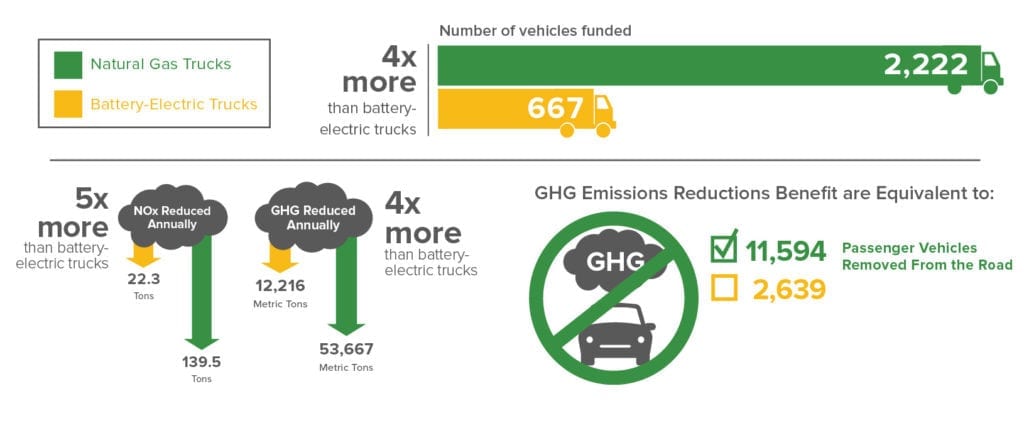Natural gas trucks are one of the best options to help California achieve clean air and climate change mitigation as quickly, effectively, and efficiently as possible. Here is why:
Natural gas truck and bus emissions are practically undetectable.
It is true that heavy-duty natural gas vehicles (ND HGVs) still produce tailpipe emissions, but the most harmful emissions—the ones that immediately impact human health and the environment—are so low that they are called “near zero emission.”
A heavy-duty truck powered by a near-zero-emission natural gas engine has tailpipe NOx emissions that are comparable to – or lower than – the amount of NOx emitted to produce electricity used to charge a similar heavy-duty battery-electric truck.
When determining total emissions, the full lifecycle of each energy source must be examined, not just the tailpipe emissions. Plug-in electric vehicles have NOx emissions associated with the electrical generators that supply power to the grid used to recharge them. Even in states with the cleanest electrical grids in the nation—California, Oregon, and Washington—NOx emission rates are 2.5 to 3.5 times higher than the near-zero emissions level of 0.02g/bhp-hr (source: www.ngvgamechanger.com).

Natural gas trucks offer the most cost-effective option to reduce NOx and GHG emissions.
Reducing diesel truck emissions quickly is the only way that California can meet its clean air objectives. Unfortunately, California does not have the means to fund the replacement of every medium- and heavy-duty vehicle in the state. Current funding available is not adequate to achieve improved air quality, National Ambient Air Quality Standards (NAAQS), and to immediately protect human health. Therefore, it is imperative that California spends its limited incentive dollars wisely, achieving the maximum amount of emission reductions for every dollar spent. The graphic below shows what a hypothetical $100 million government investment could achieve when using one of California’s most popular funding programs (HVIP).

Natural gas trucks are road-tested and offer the power and performance that fleets require.
NZE natural gas trucks are the closest direct replacement for diesel trucks in terms of operational performance. When looking across factors including range, fueling frequency and fueling speed, driver comfort and safety, and maintenance support, NGVs hold up to diesel trucks better than any other commercially available vehicle technology.
A heavy-duty natural gas vehicle typically has a range of 550 to 700 miles on a full tank. Using the total potential daily range, a HD NGV can easily drive 150,000 miles or more per year.
Because of these proven results, there are more than 175,000 heavy-duty natural gas vehicles in operation across the U.S. enabling fleets to lower operating costs, secure long-term fuel price stability, and mitigate their impact on the environment.
View case studies from a range of fleets operating natural gas vehicles.

Natural gas trucks are available at a commercial scale today from major manufacturers.
HD NGVs are commercially available today from 10 different major truck manufacturers—including Freightliner, Volvo, Kenworth, Mack, Peterbilt, and others. Retrofit and repower options are also available from a variety of manufacturers.
With these well-established brands also comes robust sales and service networks ready to support HD NGVs, especially in California where this clean air technology has been increasingly and successfully used for more than two decades.
To view the latest vehicle availability, use the U.S. Department of Energy Alternative Fuel and Advanced Vehicle Search tool.

Low NOx Certified Engines
An on-road truck with a natural gas near-zero engine (.02 g NOx / bhp-hr) is 90% cleaner than the EPA’s current heavy-duty NOx emission standard. It has equivalent NOx emissions to a heavy-duty battery electric truck when comparing NOx emissions associated with charging (even states like CA, OR, and WA, that have the cleanest electrical grids in the nation).
Sources:
- California Air Resources Board, 2019-2020 Clean Transportation Incentives Funding Plan, Appendix A. https://ww2.arb.ca.gov/sites/default/files/2019-09/fy1920fundingplan-appa.pdf
- 2018 Feasibility Assessment for Cargo-Handling Equipment, September 2019. https://www.gladstein.org/wp-content/uploads/2019/09/Final-CHE-Feasibility-Assessment_August-2019-Master.pdf
- California Air Resources Board, 2019-2020 Clean Transportation Incentives Funding Plan, Appendix A. https://ww2.arb.ca.gov/sites/default/files/2019-09/fy1920fundingplan-appa.pdf
- This emissions analysis in based on the California Air Resources Board’s assumptions from their FY19-20 funding plan, including using the average carbon intensity of RNG consumed in California in 2016 based on Low Carbon Fuel Standard data.
- Based on testing conducted by the University of California at Riverside on a 12L NZ natural gas engine (https://ucrtoday.ucr.edu/wp-content/uploads/2018/08/CWI-LowNOx-12L-NG_v03.pdf) which showed NOx emissions ranging from 0.02 to 0.11 g/mi. By comparison, the average MY2020 passenger car has NOx emissions of 0.025 g/mi (per EMFAC 2017).









